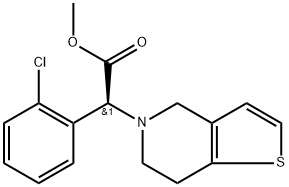Alteplase
- CAS NO.:105857-23-6
- Molecular Weight: 0
- MDL number: MFCD01775210
- Update Date: 2024-07-02 08:55:12
What is Alteplase?
Description
Alteplase is a recombinant single-chain tissue plasminogen activator useful in the management of thrombosis in acute myocardial infarct. It reportedly causes no allergic reactions but requires intravenous infusion due to a short half-life. Alteplase is the only agent on the U.S. market indicated for the reduction of incidence of congestive heart failure following a heart attack.
Originator
Genentech (USA)
The Uses of Alteplase
Tissue-type plasminogen activator; fibrinolytic.
brand name
Activase (Genentech);Actilyse.
General Description
Alteplase (Activase) is a tissue plasminogenactivator (t-PA) produced by rDNA technology. It is a single-chain glycoprotein protease consisting of 527 aminoacid residues. Native t-PA is isolated from a melanoma cellline. The single-chain molecule is susceptible to enzymaticdigestion to a two-chain molecule, in which the two chainsremain linked with a disulfide bond. Both forms of the nativet-PA are equipotent in fibrinolytic (and plasminogenactivating)properties. It is an extrinsic plasminogen activatorassociated with vascular endothelial tissue, whichpreferentially activates plasminogen bound to fibrin. Thefibrinolytic action of alteplase (t-PA) is confined to thrombi,with minimal systemic activation of plasminogen. It is producedcommercially by rDNA methods by inserting the alteplasegene (acquired from human melanoma cells) intoovarian cells of the Chinese hamster, serving as host cells.The melanoma-derived alteplase is immunologically andchemically identical with the uterine form. Alteplase is indicatedfor the intravenous management of acute myocardialinfarction.
Mechanism of action
As a main endogenic promoter of fibrinolysis, t-PA binds with fibrin and, like urokinase, breaks Arg-560–Val-561 peptide bond in the fibrin-binded plasminogen molecule, thus turning it into an active plasmin molecule that breaks apart fibrin clots. Its action is localized in thrombotic regions, and thus the likelihood of systemic fibrinolysis originating during its use is much lower than that which can originate while using streptokinase and urokinase.
Clinical Use
Alteplase (tPA) is a serine protease with a low affinity for free plasminogen but a very high affinity for the plasminogen bound to fibrin in a thrombus (fibrin-specific agent). Both streptokinase and urokinase lack this specificity (i.e., are nonspecific) and act on free plasminogen, inducing a generalized thrombolytic state. Alteplase also has a greater specificity for older clots compared with newer clots relative to streptokinase and urokinase. Alteplase was originally isolated from cultures of human melanoma cells but is now produced commercially using recombinant DNA technology.
Side Effects
Alteplase is unmodified human tPA, whereas reteplase is human tPA that has had several specific amino acid sequences removed. At low doses, alteplase is quite selective for degrading fibrin without concomitant lysis of other proteins, such as fibrinogen. At the higher doses currently used therapeutically, however, alteplase activates free plasminogen to some extent and, therefore, can cause hemorrhage. Many of the therapeutic indications for the other thrombolytic agents also are indications for alteplase (i.e., myocardial infarction, massive pulmonary embolism, and acute ischemic stroke).
Properties of Alteplase
| form | Solid |
| color | White to off-white |
Safety information for Alteplase
Computed Descriptors for Alteplase
New Products
(S)-3-Aminobutanenitrile hydrochloride 4-Methylphenylacetic acid N-Boc-D-alaninol N-BOC-D/L-ALANINOL Tert-butyl bis(2-chloroethyl)carbamate 3-Morpholino-1-(4-nitrophenyl)-5,6-dihydropyridin- 2(1H)-one Furan-2,5-Dicarboxylic Acid Tropic acid 1-Bromo-3,5-Di-Tert-Butylbenzene S-2-CHLORO PROPIONIC ACID ETHYL ISOCYANOACETATE 2-Bromo-1,3-Bis(Dimethylamino)Trimethinium Hexafluorophosphate 4-IODO BENZOIC ACID 3-NITRO-2-METHYL ANILINE 1-(2,4-DICHLOROPHENYL) ETHANAMINE (2-Hydroxyphenyl)acetonitrile 4-Bromopyrazole 2-(Cyanocyclohexyl)acetic acid 4-methoxy-3,5-dinitropyridine 1-(4-(aminomethyl)benzyl)urea hydrochloride 2-aminopropyl benzoate hydrochloride diethyl 2-(2-((tertbutoxycarbonyl)amino) ethyl)malonate tert-butyl 4- (ureidomethyl)benzylcarbamate Ethyl-2-chloro((4-methoxyphenyl)hydrazono)acetateRelated products of tetrahydrofuran








You may like
-
 2033-24-1 98%View Details
2033-24-1 98%View Details
2033-24-1 -
 42831-50-5 5-METHYLISOXAZOLE-4-CARBOXYLIC ACID 98%View Details
42831-50-5 5-METHYLISOXAZOLE-4-CARBOXYLIC ACID 98%View Details
42831-50-5 -
 1975-50-4 98%View Details
1975-50-4 98%View Details
1975-50-4 -
 2-HYDROXY BENZYL ALCOHOL 98%View Details
2-HYDROXY BENZYL ALCOHOL 98%View Details
90-01-7 -
 2-Chloro-1,3-Bis(Dimethylamino)Trimethinium Hexafluorophosphate 221615-75-4 98%View Details
2-Chloro-1,3-Bis(Dimethylamino)Trimethinium Hexafluorophosphate 221615-75-4 98%View Details
221615-75-4 -
 61397-56-6 CIS BROMO BENZOATE 98%View Details
61397-56-6 CIS BROMO BENZOATE 98%View Details
61397-56-6 -
 14714-50-2 (2-Hydroxyphenyl)acetonitrile 98+View Details
14714-50-2 (2-Hydroxyphenyl)acetonitrile 98+View Details
14714-50-2 -
 118753-70-1 98+View Details
118753-70-1 98+View Details
118753-70-1